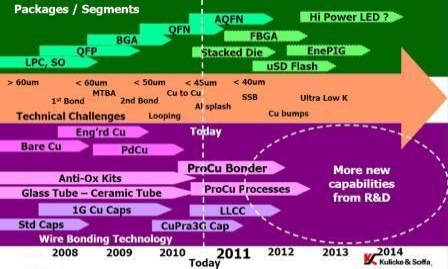February 25, 2011 – Global production value of nanocarbon products — single-walled carbon nanotubes (SWNT), multi-walled carbon nanotubes (MWNT), fullerenes, graphene, carbon nanofiber, and nanodiamonds — will triple over the next four years in value, and by orders-of-magnitude in actual production, according to a recent analyst report.
Production of carbon nano products totaled about 710 tons in 2010, for a rough value of $435M, calculates Innovative Research and Products Inc. (iRAP). The company predicts that will swell to 9,300t and $1.3B by 2015.
| 2010 |
2015 |
AAGR % (2010-2015) |
|
| SWNT | 180 | 320 | 12.2 |
| MWNT | 105 | 700 | 46.7 |
| Fullerenes | 61 | 60 | -0.33 |
| CNF | 88 | 144 | 10 |
| Graphene | 0.75 | 48 | 130 |
| TOTAL |
435 |
1272 |
24 |
Nanocarbon production value (in US $M) according to types. (Source: iRAP)
Inside the numbers, iRap finds some key trends:
- Production closing the capacity gap. Those surging output numbers for nanocarbon products suggest partially solving a more important problem: massive overcapacity. In 2010, production capacity for these materials was 4065t — actual output of 710t translates to 17% capacity utilization. (Output was only about 500t in 2009, and 340t in 2008.) But by 2015, iRap sees this gulf closing, with actual production doubling over the period to exceed 9300t (a 67.3% annual growth rate), translating to an 80% utilization based on the 12,300t of projected capacity.
Despite surging output and capacity, demand hasn’t really caught up yet, iRap notes, but suppliers want to be ready to match future demand seen coming in the next 5-10 years. Contributing to that demand spark, overall prices are coming down: the firm projects prices for all nanocarbon products will fall by an average of ~12%/year from 2010-2015.
- Nanotubes leading the way. Multiwalled carbon nanotubes (MWNT) will pace the growth, says iRap: 390t of global capacity in 2008, 1500t in 2009, >3400t in 2010, and 9400t by 2015. But single-walled carbon nanotubes (SWNT), the most expensive of the lot, are the key to the kingdom; they "are much more difficult to produce than MWCNTs," iRap notes, and are seen replacing silicon as the ubiquitous electronic starting material within the next decade or so.
- Asia is production home. Asia’s production capacity for both types of nanotubes (SWNT and MWNT) is 2×-3× higher than North America and Europe combined, says iRap. Japan is a leader in MWNT production (driven by demand for lithium-ion battery electrodes) but China and Korea are catching up fast.
Share of nanocarbon production value according to types, 2015 vs. 2010. (Source: iRAP)




